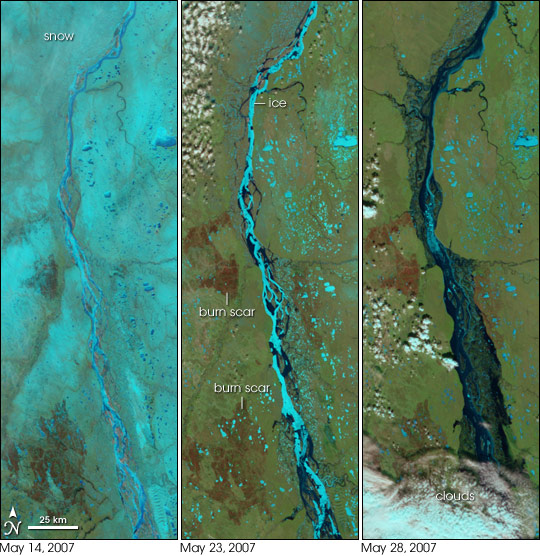


In the span of three weeks, spring crept over the Siberian landscape surrounding the northern half of the Lena River. Many of the rivers in Earth’s temperate zones run high in the spring when melting snow and spring rain flood river basins. On the Lena River, however, spring flooding is almost inevitable for another reason: ice. Like other north-flowing rivers, the upper reaches of the Lena melt before their downstream counterparts. Because the northern mouth of the river remains frozen while the southern body of the river flows freely, water naturally builds behind the ice, forming a temporary reservoir that drains as the ice dwindles. This series of images, taken by the Moderate Resolution Imaging Spectroradiometer (MODIS) on NASA’s Terra satellite, captured the spring flooding in May 2007.
The images were made with both infrared and visible light which makes water look dark blue or black, snow and ice turquoise, clouds pale blue and white, plant-covered land green, and bare earth tan. Charred land, burned by wildfire in the past year or two, is red-brown. The first image was taken on May 14, 2007, while the river was still frozen. Snow covers the ground around the river, which is winter-thin and frozen.
The second image was taken a little over a week later, on May 23. In nine days, the snow had almost entirely melted, and patches of open water formed dark blue shadows on the smooth turquoise sheet of ice that still covered most of the river. Along the lower edge of the image, the river shows signs of swelling. In the large image, which includes much more of the river basin, the southern extents of the Lena and its tributaries are dramatically flooded.
By the following week, when the last image was taken, the floods had moved north as this section of the river thawed. Water had spread far beyond the river’s banks, extending to the burn scar that had been some distance from the river’s edge the previous week. Traces of light blue line a few channels of the river in the top half of the image, indicating that ice still jams part of the river. According to the Dartmouth Flood Observatory, the May floods along the Lena and its tributaries inundated more than 1,000 houses, put 12 towns under water, damaged or destroyed 41 bridges, and affected more than 14,000 people. By May 28, when the last image was taken, water levels in the more populated southern regions had started to recede as the northern part of the river thawed.
NASA images created by Jesse Allen, using data provided courtesy of the MODIS Rapid Response team.